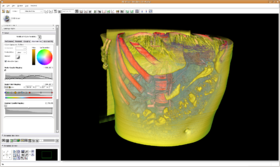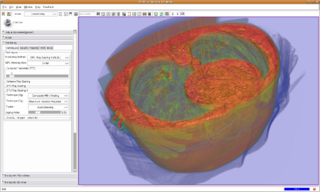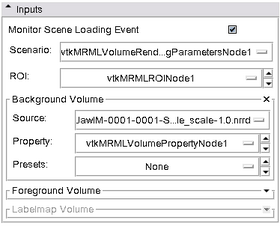Difference between revisions of "Modules:VolumeRendering-Documentation-3.6"
| Line 85: | Line 85: | ||
* '''Techniques TAB ''' Under the techniques tab, there are currently five rendering methods available. Each of these are described below. | * '''Techniques TAB ''' Under the techniques tab, there are currently five rendering methods available. Each of these are described below. | ||
** Rendering Method | ** Rendering Method | ||
| − | *** '''VTK CPU Ray Casting:''' Uses the CPU for volume rendering, is parallelized and can take advantage of multi-core capabilities. Uses level-of-detail approach where low resolution is rendered while moving, and high resolution is rendered once motion ceases. Allows zbuffer compositing with texture map cross sections and triangulated surface model. | + | *** '''VTK CPU Ray Casting:''' Uses the CPU for volume rendering, is parallelized and can take advantage of multi-core capabilities. Uses level-of-detail approach where low resolution is rendered while moving, and high resolution is rendered once motion ceases. Allows zbuffer compositing with texture map cross sections and non-transparent triangulated surface model. |
**** Method Configuration Panel: | **** Method Configuration Panel: | ||
| − | *** '''VTK GPU Ray Casting:''' Uses GPU accelerated ray caster. Allows z-buffer compositing | + | *** '''VTK GPU Ray Casting:''' Uses GPU accelerated ray caster. Allows z-buffer compositing with non-transparent polygon models only. This is currently working on Linux and Win32, but not on Mac due to a bug in the OpenGL drivers. |
**** Method Configuration Panel: | **** Method Configuration Panel: | ||
| − | *** '''VTK OpenGL 3D Texture Mapping:''' Uses texture mapping approach to volume rendering compared to the two render methods above, it has | + | *** '''VTK OpenGL 3D Texture Mapping:''' Uses texture mapping approach to volume rendering compared to the two render methods above, it has slightly lower performance and slightly coarser appearance. |
**** Method Configuration Panel: | **** Method Configuration Panel: | ||
*** '''NCI GPU Ray Casting:''' This is a GLSL-based ray caster with several experimental mapping techniques. No z-buffer compositing with polygon models. Good performance and quality. No hardware restrictions on this method. | *** '''NCI GPU Ray Casting:''' This is a GLSL-based ray caster with several experimental mapping techniques. No z-buffer compositing with polygon models. Good performance and quality. No hardware restrictions on this method. | ||
Revision as of 13:09, 18 May 2010
Home < Modules:VolumeRendering-Documentation-3.6Return to Slicer 3.6 Documentation
Module Name
Volume Rendering
General Information
Module Type & Category
Type: Interactive
Category: Base
Authors, Collaborators & Contact
- Yanling Liu, SAIC-Frederick/NCI-Frederick, Alex Yarmarkovich, Isomics, SPL
- Andreas Freudling, Student Intern at SPL (freudling@bwh.harvard.edu)
- Contact: Yanling Liu, liuy5@mail.nih.gov, Alex Yarmarkovich, alexy@bwh.harvard.edu
- Some of the transfer functions were contributed by Kitware, Inc. (VolView)
Module Description
Provides interactive visualization of 3D image data. To learn about volume rendering start with Wikipedia.
Usage
Use Cases, Examples
- Pausing VolumeRendering module in scene loading
The VolumeRendering module can be paused in scene loading by un-checking the "Monitor Scene Loading Event" check button. Re-checking the check button will flush the paused pipeline and initialize the module using the loaded scene.
- Multi-Volume GPU Ray Casting
VolumeRendering module has the capability to blend two (bg and fg) volumes in one rendering pipeline. User may select different rendering technique for bg or fg volumes. Different blending options are also available.
Currently under development. Available rendering techniques: Composite (bg) + Composite (fg) + OR blending, Composite (bg) + Composite (fg) + AND blending, Composite (bg) + MIP (fg), MIP (bg) + MIP (fg).
- Dual 3D View mode
VTK GPU Ray Casting doesn't support the Dual 3D View mode.
- Volume-Following Mode
In Volume-Following mode, color and opacity transfer functions in the VolumeRendering module will follow window/level and threshold settings in the Volumes module for a uniform appearance on both slice view and 3D volume rendering view. To use, check VolumeRendering module -> Rendering panel -> Volume Property tab -> Follow Volumes Module check button.
In Volume-Following mode, window/level plus lookup table in Volumes module will be used to set colors in volume rendering. Threshold in Volumes module will be used to set opacity in volume rendering. Color and opacity transfer function editor also are disabled in Volume-Following mode because we are following volumes module now.
Tutorials
Quick Tour of Features and Use
|
|
|
Rendering panel: This panel is Dynamically generated panel when valid input is selected.
|
|
|
Volume Property Tab
|
|
|
ROI Tab
|
|
|
Misc Tab
|
Development
Notes from the Developer(s)
Dependencies
None.
Tests
On the Dashboard, these tests verify that the module is working on various platforms
Known bugs
Links to known bugs in the Slicer3 bug tracker
Usability issues
Follow this link to the Slicer3 bug tracker. Please select the usability issue category when browsing or contributing.
Source code & documentation
Source code: http://viewvc.slicer.org/viewcvs.cgi/branches/Slicer-3-6/Modules/VolumeRendering/?rev=13274
Doxygen documentation: http://www.na-mic.org/Slicer/Documentation/Slicer3-doc/html/classes.html
More Information
Acknowledgment
This work is supported by NA-MIC, NAC, BIRN, NCIGT, and the Slicer Community. See http://www.slicer.org for details. The VolumeRendering module is implemented by Yanling Liu, NCI-Frederick/SAIC-Frederick, Andreas Freudling, Student Intern at SPL, BWH (Ron Kikinis) and Alex Yarmarkovich, Isomics Inc. (Steve Pieper). Some of the transfer functions were contributed by Kitware, Inc. (VolView)".
References
Publications related to this module go here. Links to pdfs would be useful.












